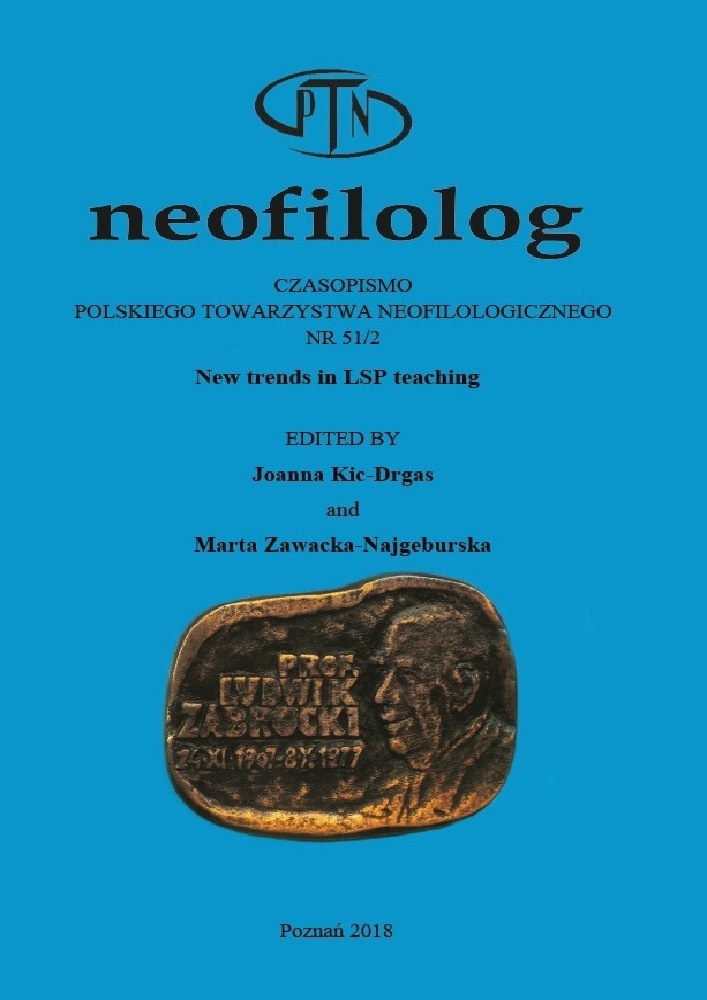Résumé
The article explores the influence of the specialised language on the shaping of the image of the German car brand Volkswagen. The analysed material comprises marketing texts from an image magazine of the Volkswagen Magazin brand, available on the company’s website. The issue will be examined on the basis of the semantic category of Electro Mobility, which constitutes a subcategory of the semantic category of innovation, which in turn is currently the company’s main area of activity and the focus of all actions, also linguistic, in terms of shaping the brand’s image. The specialised language in the texts from the Magazine, a digital journal, whose articles resemble forms of journalistic writing, limits itself mainly to specialist vocabulary – the technical vocabulary referring to automotive technology, as well as pseudo-specialised language, whose role is merely to evoke technical connotations. Both types of specialist terminology contribute to the restoring of the reputation of the brand in the eyes of the consumers, which has been severely affected as a result of the emissions scandal in 2015.
Références
Bastian S., Koppe K., Lenk, M., Noack, S. (2000), Nanocapsule de vitamine E pure”, „Double Sérum 38“, „l'élimination des bactéries de la vaisselle...? Vom Sinn und Unsinn fachsprachlicher Mittel in der „Werbung“ (in) Morgenroth, K. (Hrsg.), Hermetik und Manipulation in den Fachsprachen. Tübingen: Narr Francke Attempto, S. 83-106.
Filip G. (2014), Personifikacja jako sposób brandingu VW na rynku polskim na przykładzie. „Volkswagen Magazyn” i „Das Auto. Magazyn (in) Мартинова Г.І. (Hrsg.), Мовознавчий Вісник. Збірник наукових праць. Випуск 19. Черкаси: Міністерство о Світи і Науки України Черкаський Національний Університет Імені Богдана Хмельницького, S. 154-160.
Fluck H.-R. (1996), Fachsprachen. Bern und München: Francke.
Gläser R. (1990), Fachtextsorten im Englischen. Tübingen: Narr.
Grucza F. (2008), Języki specjalistyczne – indykatory i/lub determinanty rozwoju cywilizacyjnego (in) Lukszyn J. (Hrsg.), Podstawy technolingwistyki I, S. 5-23.
Grucza S. (2013), Od lingwistyki tekstu do lingwistyki tekstu specjalistycznego. Warszawa: Wydawnictwo Naukowe Instytutu Kulturologii i Lingwistyki Antropocentrycznej.
Grünert H. (1984), Deutsche Sprachgeschichte und politische Geschichte in ihrer Verflechtung (in) Besch, W. u.a. (Hrsg.), Sprachgeschichte, S. 29-37.
Habrajska G. (2005), Nakłanianie, perswazja, manipulacja językowa (in) “Acta Universitatis Lodziensis Folia Litteraria Polonica”, No 7, S. 91-125.
Jakob K. (1991), Maschine, Mentales Modell, Metapher. Tübingen: Niemeyer.
Janich N. (1998), Fachliche Information und inszenierte Wissenschaft. Tübingen: Narr.
Janich N. (2001), Fachliches in der Werbung (in) Wichter S., Antos G. (Hrsg.), Wissenstransfer zwischen Experten und Laien. Frankfurt am Main: Lang, S. 257-274.
Janich N. (Hrsg.) (2009), Marke und Gesellschaft. Wiesbaden: Verlag für Sozialwissenschaften.
Kampker A. (Hrsg.) (2013), Elektromobilität: Grundlagen einer Zukunftstechnologie. Berlin: Springer Vieweg.
Lewicki A. M. (2002), Obraz samochodu w sloganach reklamowych (in) Anusiewicz J., Bartmiński J. (Hrsg.), Język a kultura, t. 12, Stereotyp jako przedmiot lingwistyki. Wrocław: Wydawnictwo Uniwersytetu Wrocławskiego, str. 206−223.
Ligara B., Szupelak W. (2012), Lingwistyka i glottodydaktyka języków specjalistycznych na przykładzie języka biznesu. Podejście porównawcze. Kraków: Księgarnia Akademicka.
Łuczak M., Małys Ł. (2016), Współczesne koncepcje i trendy w branży motoryzacyjnej. Poznań: Advertiva.
Morgenroth K. (2000), Die Alchemie in der Wissenschaft: fachsprachliche Hermetik und pseudofachsprachliche Manipulation – Zur Einführung (in) Morgenroth K., Die Alchemie in der Wissenschaft: fachsprachliche Hermetik und pseudofachsprachliche Manipulation (Hrsg.), Hermetik und Manipulation in den Fachsprachen. Tübingen: Narr, S. 9 – 40.
Ożóg K. (2001), Polszczyzna przełomu XX i XXI wieku: wybrane zagadnienia. Rzeszów: Wydawnictwo Stowarzyszenie Literacko-Artystyczne „Fraza”.
Wilczek W. (2016), Polski język motoryzacyjny początku XXI wieku. Katowice: Wydawnictwo Uniwersytetu Śląskiego.
Licence
© Neofilolog 2018

Ce travail est disponible sous licence Creative Commons Attribution - Pas de Modification 4.0 International.
Auteurs :
Les auteurs de textes acceptés pour publication dans la revue Neofilolog sont tenus de remplir, signer et renvoyer à l'adresse de la rédaction, un accord sur l'octroi d'une licence gratuite pour les œuvres, avec obligation d'accorder une sous-licence CC.
En vertu de cet accord, les auteurs des textes publiés dans la revue Neofilolog accordent à l'Université Adam Mickiewicz de Poznań une licence non exclusive et gratuite et permettent l'utilisation de la sous-licence Creative Commons Attribution-NoDerivatives 4.0 International (CC BY-ND 4.0).
Les auteurs se réservent le droit de disposer librement de l'œuvre.
Utilisateurs :
Les utilisateurs d'Internet intéressés ont le droit d'utiliser les œuvres publiées à partir de l'année 2017 sous réserve des conditions suivantes :
- reconnaissance de la qualité d'auteur - l'obligation de fournir des informations sur la qualité d'auteur, le titre, la source (liens vers l'œuvre originale, DOI) et la licence, ainsi que l'œuvre distribuée ;
- sans créer d'œuvres dérivées - l'œuvre doit être conservée dans sa forme originale, p. ex. les traductions ou les interprétations ne peuvent être distribuées sans le consentement de l'auteur.
Tous les textes publiés sont soumis au droit d'auteur.
Autres :
L'Université Adam Mickiewicz de Poznań se réserve le droit à la revue dans son ensemble (mise en page, forme graphique, titre, conception de la couverture, logo, etc.).
.

